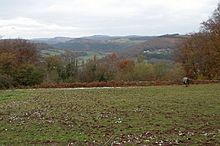The Hudnalls facts for kids
| Site of Special Scientific Interest | |

View from The Hudnalls
|
|
| Area of Search | Gloucestershire |
|---|---|
| Grid reference | & & |
| Coordinates | 51°43′27″N 2°40′36″W / 51.724218°N 2.67677°W |
| Interest | Biological |
| Area | 94.4 hectare |
| Notification | 1972 |
The Hudnalls is a special natural area in Gloucestershire, England. It covers about 94.4 hectares, which is like 233 football fields! This area was officially recognized in 1972. It's known as a Site of Special Scientific Interest (SSSI) because of its amazing wildlife.
The Hudnalls includes areas called The Tuffs and The Nedge. It's also listed as a Key Wildlife Site (KWS) in the local plan for the Forest of Dean. The woodlands here are part of the wider Wye Valley Woodlands. These woodlands are so important that they are a Special Area of Conservation (SAC) under European rules. This means they get extra protection to keep their habitats safe.
Exploring The Hudnalls: Location and Habitats
The Hudnalls is made up of eight different sections of woodland. These woodlands are found in the beautiful Wye Valley Area of Outstanding Natural Beauty. Part of this special area is also registered as Common Land, which means it can be used by local people.
The Wye Valley is a very important place in southern Great Britain for protecting woodlands. There are many natural woodlands that stretch continuously along the river gorge. Several other SSSIs are also found in this region. The trees in these woodlands are very diverse, with many local and even rare types growing here. You can also find natural grasslands mixed in with the woods. This creates a rich mix of different places for plants and animals to live.
The Hudnalls itself is on steep slopes that face north and west. These slopes are along the sides of the River Wye and a smaller stream called the Mork Brook. The area is located between the villages of Bigsweir and Brockweir. There is also some flatter land at The Tuffs.
The soil in The Hudnalls is mostly acidic. It's made from Old Red Sandstones, quartz, and other materials. However, in places where there are springs, streams, and wet areas, the soil becomes alkaline. This mix of different rocks and soils, along with how the land has been used over time, has created a very interesting and diverse place. Studies have found at least eleven different types of broadleaved woodland here. Each type of woodland has its own unique plants growing on the ground.
Types of Woodlands and Plants
Near the River Wye, you can find beech woodlands. These are ancient woods that were once managed by a method called coppiceing. These woods also have sessile oak and pedunculated oak trees. Other trees include ash, small-leaved lime, and silver birch.
The lower layer of plants, called the shrub layer, includes holly and hazel. On the ground, you might see plants like bramble, ivy, and different kinds of ferns. A very rare plant called Wood fescue (Festuca altissima) also grows here.
Some parts of The Hudnalls are covered in oak woodland. These oak woods were also often coppiced in the past. The plants growing on the ground in these areas include bilberry, bracken, and great wood-rush.
In areas like The Tuffs and Mocking Hazell Wood, you can find plants like dog's mercury and bluebell. A special fern called Gymnocarpium dryopteris has also been found in these woods. This fern is close to the southern edge of where it usually grows.
The southern part of The Hudnalls is mostly covered by oak-lime woodland. There aren't many shrubs in this area, but the ground is full of plants. These include yellow archangel and more wood fescue.
Along the sides of streams, especially in The Tuffs, you can see Alder trees growing.
Barbadoes Wood has a particularly rich variety of ground plants. These include many ferns and saxifrages. You can also find hornbeam and alder buckthorn here. These two plants are special because they are mostly found only in the Wye Valley. This wood also has many different types of bryophytes, which are small, moss-like plants.
Amazing Animals of The Hudnalls
The woodlands at The Hudnalls are home to many different birds. Some of the birds that breed here include the wood warbler, pied flycatcher, hawfinch, great spotted woodpecker, and lesser spotted woodpecker. You might also see hunting birds like the buzzard and sparrowhawk flying overhead.

